I have some fun information to share with you today! So, as a mama of four big kids (my baby just went off to kindergarten!), I have to live vicariously in the baby stage by sharing information about baby development. Luckily, as a pediatric occupational therapist, developmental milestones and other child development aspects is part of the job! Today, we’re covering all things spatial awareness for babies, including how visual spatial skills develop through play and tummy time. For our young babies, time on the tummy time mat is so important for development of spatial reasoning and the bodily kinesthetic intelligence that goes along with it! With tummy time play comes skills like spatial reasoning, eye-hand coordination, motor skills, and spatial ability for function. Read on for some FUN ways to encourage spatial skills through play!
Be sure to read this resource on baby container syndrome for recommendations from an occupational therapist for best positioning to develop visual spatial skills in infants and babies.
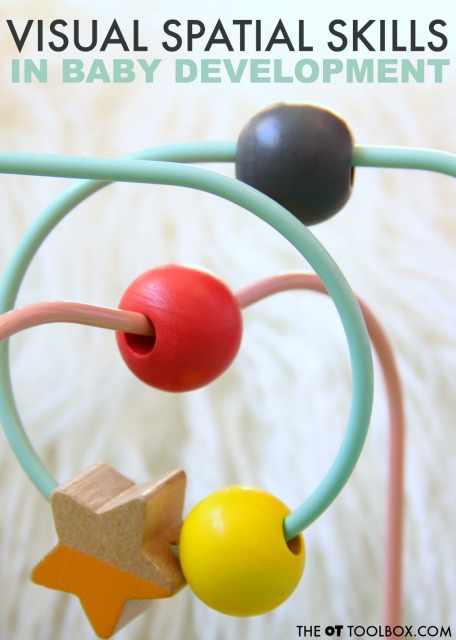
Resource for New Parents
Many people think new parents are the only ones that need baby advice. Maybe you found yourself as a new mother who suddenly had a lot of questions on sleep patterns, eating and childhood milestones. But, if there is one thing that therapists wish they could tell new parents, it’s that parents could have a better understanding of how movement plays into development.
Therapists are many times, seeking resources to share with parents to support a family through the first year of baby’s development so they can thrive.
Remarkable Infants is a great opportunity for parents and professionals alike to educate more people on how to support a baby’s first-year development for future learning development.
Yes, this course does provide information on helping a baby sleep and eat, but this course is the other more comprehensive sections. The pieces most other baby trainings don’t provide.
It’s a 5-step, all-inclusive online training for new moms focusing on the development of the whole child from birth through 12 months of age. It includes the following:
- Language Development (Talking with your baby)
- Healthy Sleep Habits (Understanding baby sleep)
- Cognitive Development and Motor Development (Playing with your Baby)
- Reading with your Baby (Vocabulary, visual-motor, speech and language)
- Infant Nutrition (Feeding your baby)
Even though this course is geared to moms, it’s also great for professionals. It can be a HUGE help to clients, expecting moms you work with and those that have kids with learning challenges. The more we can help educate parents on the necessity of building a baby’s cognition, speech and language and motor movements in their first year, the further ahead that child will be later in life.
The 2 best parts are:
1. Each section is taught by a specific professional (Occupational Therapist, Speech and Language Pathologist, Pediatric Sleep Sleep Specialists and Registered Dietitian) with evidence-based research. So you know you’re getting advice from the pros!
Spatial Awareness For Baby
What is spatial awareness? Spatial awareness in early childhood is so important to child development!
We’ve talked a lot about spatial awareness in handwriting. But, what exactly is spatial awareness and how does it develop? Spatial relations allows the organization of the body in relation to objects. This is an important part of movement-based activities. Knowing where your body is in space and in relation to the world around you is so important for learning, development, and gaining skills. For young babies, spatial awareness develops through movement and exploring the world around them.
An important part of spatial awareness is the visual component. In order to reach for a toy that is nearby, a baby must first visually see the ball, be aware of where their body is in space, and use coordinated effort to reach for that toy. All of this sense of space is a part of bodily kinesthetic intelligence and using that information to perform actions.
Another essential piece is the body awareness. For young babies, knowing where their body is in space is important for reaching, grabbing, rolling, crawling, and walking. You can see how the beginning stages of play has a big part in child development. Helping babies understand body awareness is a wonderful thing!
Having the weight of a toy or the weight of moving to reach for a toy provides proprioceptive input and feedback, with helps with body awareness.
Spatial awareness is also the ability to understand how objects relate and interact with one another. Play is a big part of this piece of the visual spatial puzzle. Toys move, blocks stack, balls roll…For a baby, understanding how all of this works develops through play.
Giving kids the words they need to understand their spatial sense is powerful. By saying words like, up, down, under, in, and behind, we label where objects are in relation to one another. Playing in tummy time is a great way for babies to establish these building blocks of learning. It’s just another reason why tummy time is so important for babies!
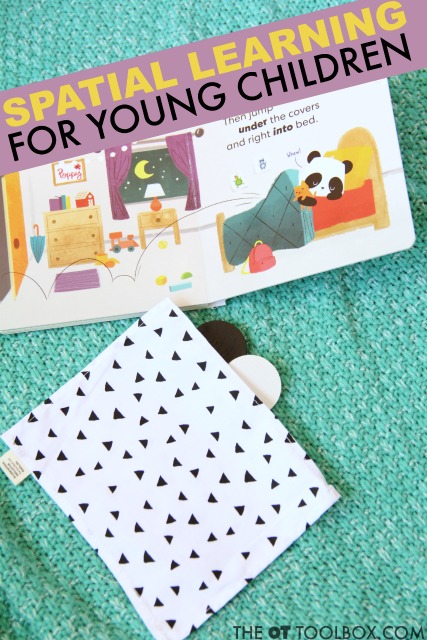
Spatial SKills for Babies
Play for babies offers so many valuable lessons. Getting down on the floor with a few toys is an opportunity to refine beginning understanding of spatial skills. By using a few items designed to promote spatial learning, babies can establish the skills they need to learn. One tool to support this skill development is through floor play with little ones.
Using a baby gym allows parents, caregivers, or siblings to get down on the floor for building strong core and neck muscles, and the visual motor skills for intentional reach, which is one of the building blocks to fine motor development.
We had the chance to check out a Panda Crate from Kiwi Crate and found some great items inside that are perfect for teaching spatial skills and spatial reasoning. Try some of the ideas below to work on skills that small children will use as they grow.
Some of the spatial skills that you can work on during tummy time play include:
- Spatial reasoning (comparing size, volume, weight, object permanence)
- Spatial perception
- Sense of self
- Body awareness
- Spatial language (spatial learning)
- Eye-hand coordination
- Cause-effect
- Kinesthetic intelligence
- Spatial exploration- including concepts like in, out, behind, under, on top, etc.
There are other child development benefits that occur through tummy time play too:
- Fine motor skills
- Gross motor skills
- Strength and stability
- Early math concepts
- Directionality
- Tactile play
- Problem solving
- Visual processing
- Sensory processing
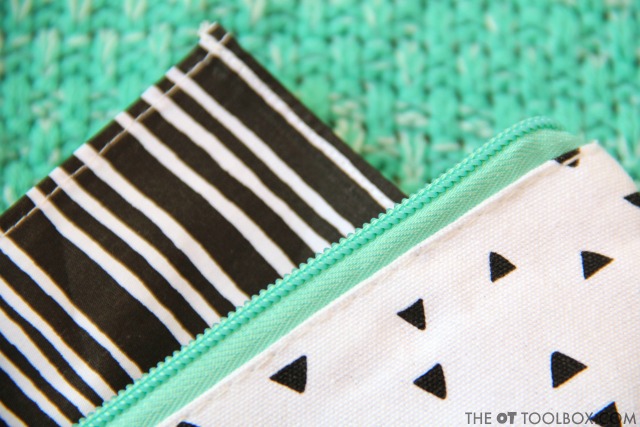
Use patterned cloth squares to hide in a zippered pouch- This simple play activity teaches babies so many skills. Part of spatial reasoning includes realizing that when an object is out of view, it still exists. This piece of child development is an important milestone in cognition for babies. It is a skill that evolves into stranger danger and a sense of self as baby develops.
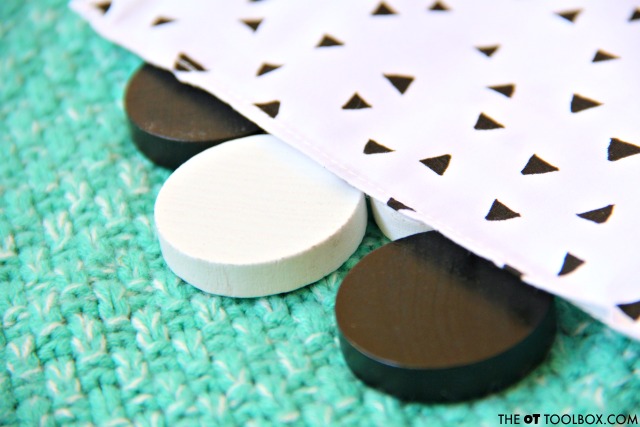
Use small objects like these wooden coins (big enough that they are safe for baby!) to “hide” under a blanket or cloth. Hiding objects is a great way to work on object permanence, and spatial language such as the word “under”. These skills are the building blocks of spatial recognition and spatial reasoning.
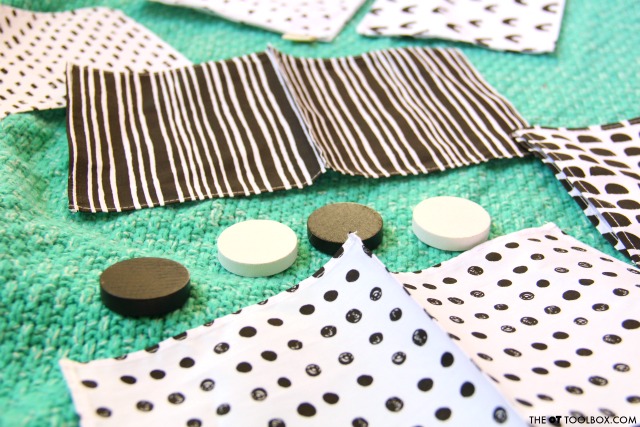
Create a DIY tummy time mat with fabric squares and small toys. Using high-contrasting patterns in black and white provides an engaging and vivid visual prompt for babies. They are motivated to reach and grab for the objects on the tummy time mat while working those reaching and eye-hand coordination skills. Where does the objects go as soon as baby grabs them? Right to their mouth as they explore…and that is ok!
Using items that are safe for baby, like these toys in the Panda Crate makes playtime safe. And, when baby brings those items to their mouth, they are learning about weight of the object, tactile sensation, and with visual processing benefits too: visual convergence, motor planning, eye-hand coordination and bilateral coordination.
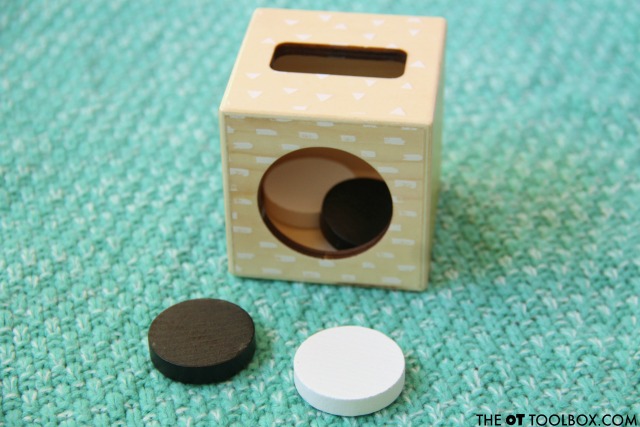
Work on spatial reasoning by allowing baby to put items into and pull items out of a small space. By manipulating baby-safe objects, they learn to control their movements (eye-hand coordination) that is necessary for refined fine motor skills in coloring and managing clothing fasteners down the road.
Be sure to use spatial language such as “in” and “out” to label the child’s movements and really work on that spatial awareness.
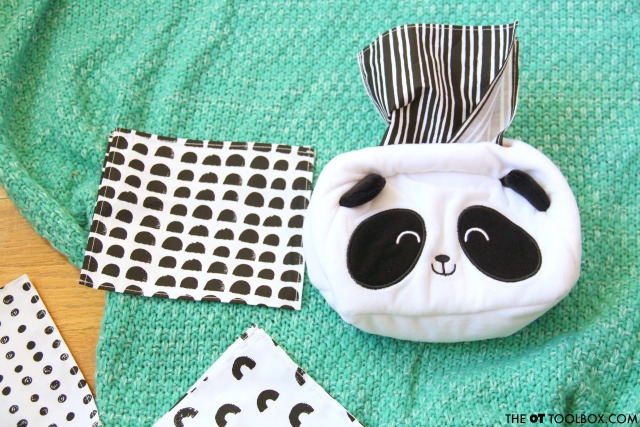
Spatial concepts such as empty and full are a building block of spatial learning. Grabbing fabric swatches from a container like this soft tissue box from Panda Crate offers early math concepts and spatial ability needed as they grow and develop.
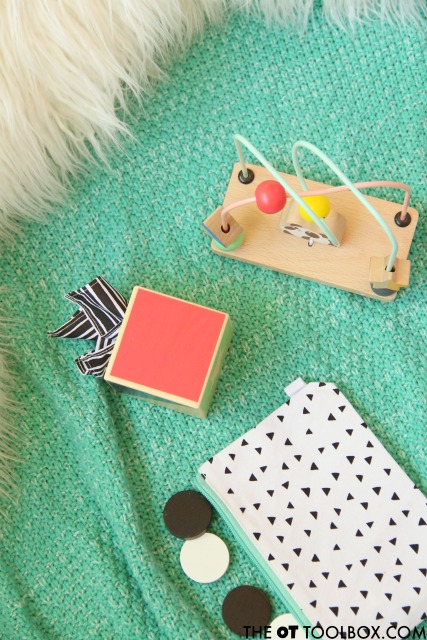
Make a DIY tummy time mat using a blanket and some scattered toys that encourage reaching, rolling, and pivoting on the belly. All of these movements are pivotal in crawling and the strength that will be needed down the road for things like writing!
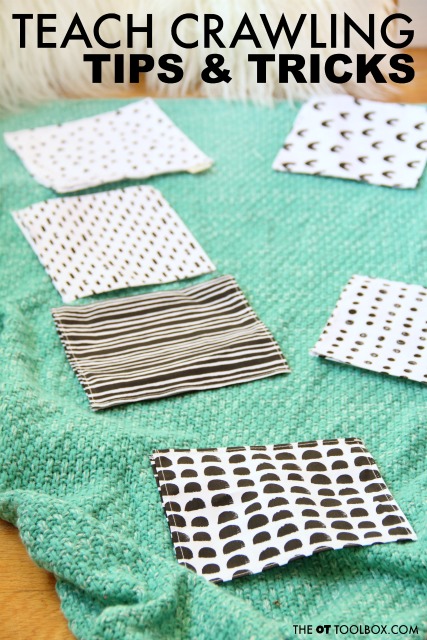
In fact, those movements (reaching, pivoting on the belly, and rolling toward a desired target (like black and white fabric swatches) can be helpful in teaching babies to crawl. This developmental milestone can be helped along by spreading out a blanket and scattering engaging items just out of reach. Make them a little further apart to encourage more reaching and scooting along on the floor.
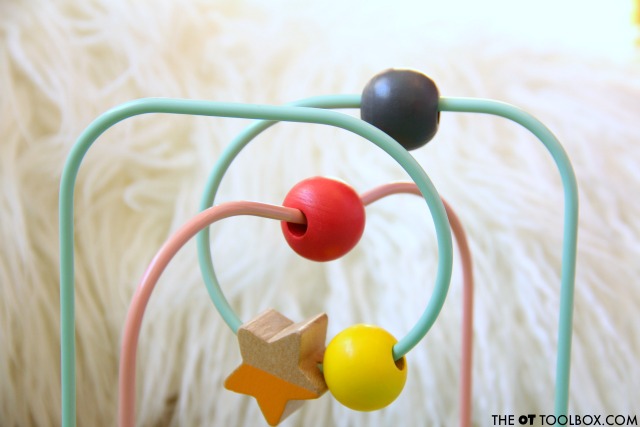
There are so many ways to work on the essential skills kids need through tummy time and floor play. Babies will develop the spatial awareness they need as they explore how their body works and the objects around them.
Want more ways to give babies the skills they need? The Panda Crate from Kiwi Crate was really fun to explore with a therapist’s lens on child development.
These would be a great recommendation from therapist as toys that parents can use at home to build the skills kids need. They make awesome gift ideas from a therapist or parent who loves skill building toys!
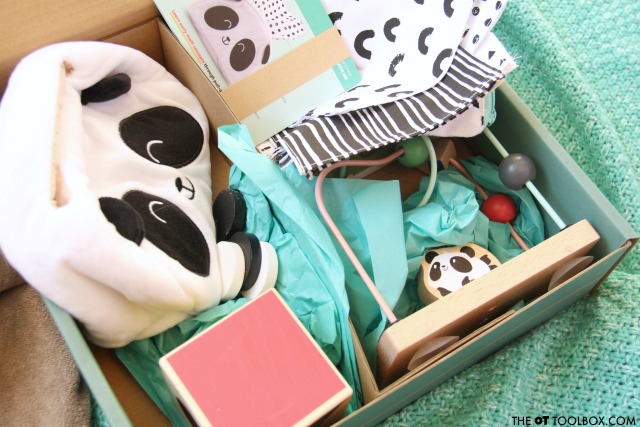
Panda Crate Deal
Use the code SHARE30 to save 30% on your first month’s box. Click here to get your Panda Crate with the savings and start playing!
Disclosure: We received a Panda Crate to check out, but only recommend items that we feel will really benefit you, the reader. All opinions and information in this blog post are our own.

Colleen Beck, OTR/L has been an occupational therapist since 2000, working in school-based, hand therapy, outpatient peds, EI, and SNF. Colleen created The OT Toolbox to inspire therapists, teachers, and parents with easy and fun tools to help children thrive. Read her story about going from an OT making $3/hour (after paying for kids’ childcare) to a full-time OT resource creator for millions of readers. Want to collaborate? Send an email to contact@theottoolbox.com.


